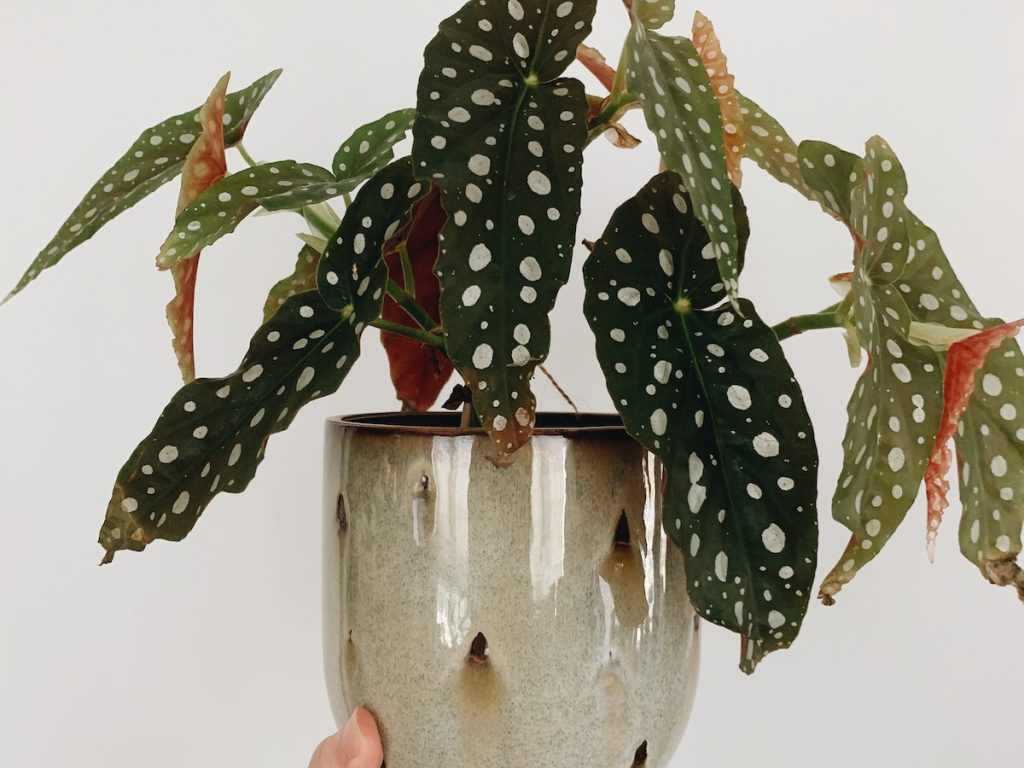The term “angel wing begonia” refers to the plant’s amazing heart-shaped leaves, which resemble folded wings. When used as a floor or tabletop houseplant, it emits a vibrant, elegant aura that astounds onlookers. The angel wing begonia is a joy to raise, but it may be very problematic for some plant parents, particularly after it sheds leaves. So, can a begonia survive without leaves?
Yes, if you can nurse it back to health. Under poor circumstances, the begonia might start to lose a lot of leaves. There are many different causes for this, such as excessive watering, inadequate light, dehydration, improper repotting, and worm infestation. Thankfully, most reasons can be addressed and do not cause lasting harm.
To learn more about taking care of a begonia, continue reading below.

Table of Contents
Can A Begonia Survive Without Leaves?
Raising the angel wing begonia is a lot of fun, but it can be a pain for some home gardeners, especially once it starts shedding leaves. The reason is typically both curable and preventive, which means that your Begonia has a fat chance of surviving even after dropping many of its leaves.
Here are some of the ways you can rescue your begonia if you find it dropping leaves:
Use Fungicide
Look for indications of a fungus infection on the stems and foliage. A few fungi-related illnesses, including powdery mildew and gray mold, can affect begonias. Look for light-colored, feathery growth on the blossoms, underneath the leaves, or at the stem’s base.
A fungicide appropriate for blooming plants should be applied, and any damaged leaves or stems should be cut off.
This video demonstrates how you can make a cheap homemade fungicide for your begonia:
Use Insecticides
Look underneath the leaves for little brown spots or holes bitten through the leaves, which are indications of an insect infestation. Use a pesticide suitable for flowering plants on the begonias or get rid of any pest-infested plants.
Avoid Overwatering
To determine how dry the earth is, dig your finger into it. Begonias require constantly wet, well-draining soil. The begonias probably contain too much water if somehow the soil feels damp or if you compress some and it flows instead of keeping it compact.
You may either wait an additional day through watering or add peat moss to the soil to aid with drainage. Water the plants more frequently if the soil seems dry at least 1 inch beneath the surface.
Adjust Placement
Watch how much light the begonias receive throughout the day. Since these plants prefer some shade, exposure to direct sunlight might burn their leaves and make them wilt. If required, relocate the plants to a spot that gets dappled light throughout the day or so they get cool morning sun instead of the scorching afternoon sun.
Fix Root Rot
Remove the plant from the pot to look for root rot, especially if the wilting is primarily on one side. Remove some dirt from the roots; they need to be white, healthy-looking, and solid. Because the root rot fungus grows in the soil, you must start over if you want to try to rescue the plant.
If the roots are black or gooey, trim them off using pruning scissors and discard the potting soil in a garbage bag. Add sterilized potting mix after cleaning the pot with bleach. Because root rot is more frequent in wet soil, replant the begonia and water it thoroughly. If the plant is outside, relocate it to a different area to help avoid the root rot fungus from reinfecting it.
Moist Air
The biggest issue with contemporary houses is the dry air, which results in leaf drop and brown margins on the plant. Considering that the plants are native to wet climates, they are less effective in pumping water to the leaf edges than weeds in our yards, which appear to be able to withstand any amount of dryness.
However, leaf drop does not always indicate death—if it takes place outside of the growth season. That is because of the extensive winter hibernation of several varieties. No matter how much fertilizer you use, leaves will eventually start to yellow and fall.
Luckily, the begonia can survive without any leaves. While waiting for the light to send a message that longer days have returned and it is okay to put out new leaf development once again, hibernating leafless plants take on the look of a mound of snakes coiling on the earth.

Distilled Water
Tap water quality is the second element to growing begonias successfully. Rex begonias have no way of dealing with salt loads; hence, “hard” water with significant mineral salt concentration causes leaf edge burn in them. They developed where there was no salinity in the water and heavy seasonal precipitation.
When given salty water, they move it to the margins of the leaves, where it evaporates and leaves the same salts at the pores. The buildup scorches the leaf margins, turning them brown and lifeless. Using distilled water or rainfall will solve the problem if your neighborhood has hard tap water.
Can You Remove Leaves from Begonia
By employing leaf cuttings, you may expand the number of begonias in your garden. Begonias grow well from leaf cuttings; therefore, summer is the best season to take leaf cuttings from your plants. The tissue between the leaf veins will sprout a new plant, which will eventually take root in the soil. After that, all you must do is detach each young plant from its mother leaf and pot it.
You can utilize a single leaf to generate several new plants that you can present to friends or use to expand your personal collection of begonias. All begonias can be treated with this method; however, foliage plants like Begonia rex benefit the most.
How Can I Get the Leaves Off a Begonia?
The steps listed below can help you if you’re wondering how to remove begonia leaves.
- Start by cutting the leaf. Cut a leaf that is fresh, clean, and healthy directly at the stem. Remove the stalk.
- Next, insert the leaf into the soil. Make cuts along the major vein’s underside. Pin the entire leaf to the hard, wet compost.
- Now, all you have to do is wait for growth. Warmth and moisture will promote development at the vein’s affected regions. On every leaf, many new plants will emerge.
Final Thoughts
So, can a begonia survive without leaves? If you can bring it back to a healthy state, yes. Hopefully, this post has provided you some insight into why your begonia is losing leaves and some advice on how to revive it. Although growing indoor plants might be challenging at times, every difficulty you overcome helps you gain the knowledge and abilities you need to avoid running into the same issue again.
Recent Posts
Have you found yourself wondering, 'why is my bamboo growing so slow?' Despite the fact that bamboo plants are remarkably fast-growing, it can sometimes take months (or even years!) to see any signs...
Miracle-Gro is a huge help when you are trying to get decent yields out of your plants or if you want them to thrive. However, you may have noticed that a single dose of fertilizer does little to...
